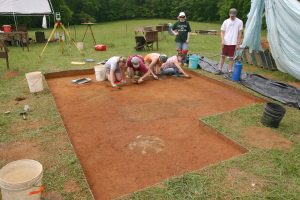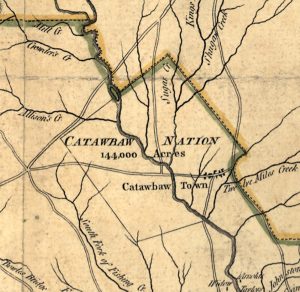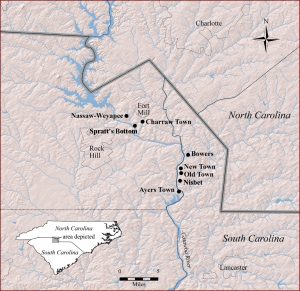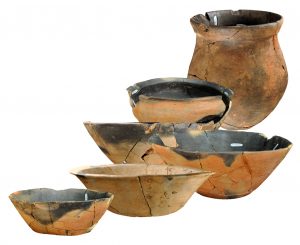Catawba Project
| The Catawba Project is a long-term project of the Research Laboratories of Archaeology (RLA) that examines the evolution of native societies of the Carolina piedmont through the eighteenth and early nineteenth centuries. The project is geographically centered along the Catawba River within the boundary of the 1760-1840 reservation of the Catawba Nation, along Catawba River in York and Lancaster counties, South Carolina. Begun in 2001 by R. P. Stephen Davis, Jr. and Brett H. Riggs, the Catawba Project has excavated numerous Catawba settlements dating between 1700 and 1820, as well as other earlier and later sites. |
| • How did the Catawba Nation accommodate and adapt to extreme and rapid changes in the cultural and sociopolitical landscapes during the latter half of the eighteenth century?
• What impact did the development of the Catawba land-leasing system have on Catawba households and their overall economies? • How and why did the Catawba pottery-making tradition change during the eighteenth and early nineteenth centuries? |
 |
Catawba SitesLearn more about the investigations at Nassaw, Weyapee, and Charraw Towns (c. 1750-1759), Old Town (c. 1763-1790), the Nisbet site (c. 1763-1780), Ayers Town (c. 1781-1800), New Town (c. 1790-1820), and the Bowers site (c. 1800-1820). |
Continuing a Legacy in Student TrainingSupported by funding from the National Geographic Society, Kanawha Development LLC, South Carolina Department of Transportation, Duke Energy, and the University of North Carolina at Chapel Hill, the Catawba Project continues the RLA’s legacy in training students in archaeological field techniques. Check out pictures of the excavation teams (supervisors, field school students, and other crew members) between 2003 and 2017. Are you in one of these photographs? |
 |
For More Information…For inquiries about the Catawba Project, please contact Dr. Steve Davis. Several 3D models of important artifacts from the Catawba Project excavations have been created by RLA students and staff. Take a look for yourself! These and many other 3D models can be viewed on the RLA’s Sketchfab page. The more significant results of this research have been extensively reported in several doctoral dissertations and more than a dozen research reports and journal articles, among other publications. To read more about the project, check out the Selected Bibliography. |



